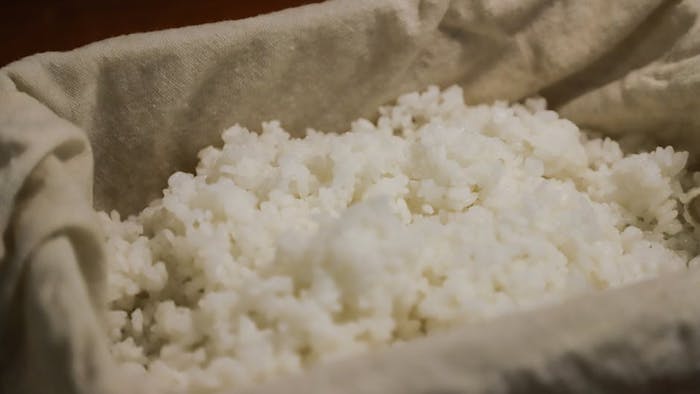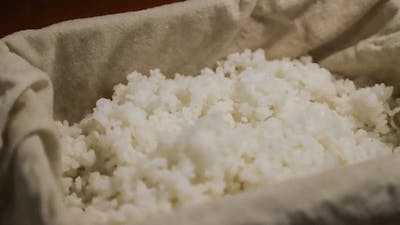We are reader supported. When you purchase through links on our site, we may earn an affiliate commission. Also, as an Amazon affiliate, we earn from qualifying purchases.

I went to a Japanese restaurant last week with my friends and ordered sushi. To my surprise, the sushi did not taste as sweet as the ones I have tasted in California. I was curious to know what brings that difference. Is it because the sushi I have tasted before was slightly modified to appeal the westerners? What about traditional sushi rice made in the authentic Japanese way?
Do you need to add sugar to sushi rice? Yes, but only as much to offset the sour taste of vinegar (about 2 tablespoons for 100 grams of rice). I would say the amount of sugar added to sushi varies widely depending upon the location. In western countries, people prefer sushi that is more on the sweeter side while the Japanese like their sushi with just a little sugar and without being slathered with non-traditional sauces.
To understand why sugar is added at all, you need to take a look into the history of how Sushi originated in the first place. East Asia has numerous rice fields that are dug a few feet deeper than ground level. Whenever a nearby river floods, the water flows in and fills these paddy fields, making conditions favorable for growing rice.
In the past, flood water caused
In modern times, people use vinegar fish to the rice in a shorter period than keeping it for months. Vinegar adds a sour taste to rice, hence sugar is added to combat the sourness. It really depends on you how sour or sweet you want your sushi to taste.
How Often Does Sushi Rice Have Sugar Added?
Almost always, but the ratio may vary widely depending on your personal preference, taste, and location. Although Sushi is a Japanese delicacy, its popularity has made available in different corners of the world.
In the western countries, they tend to add more sugar to camouflage the sour taste. Your sushi rice will also be served with several types of seasonings and non-traditional sauces that further change the flavor. In most western countries, you can expect to find a sweeter version of sushi.
If you visit a restaurant run by a Japanese or you are fortunate enough to eat traditional sushi in Japan, the taste will be slightly different from what you find elsewhere. While they still add sugar to rice, the taste is more inclined towards sour. You can clearly feel the tinge of vinegar that lends that unique aroma and taste to sushi rice.
Most sushi recipes include sugar as an essential ingredient along with salt and vinegar. The combination of vinegar and sugar gives sushi rice a yummy taste. The ratio is roughly like 4:2:1 (vinegar:sugar: salt) for a balanced flavor. Some sushi preparations include a Kazu (red vinegar) that has naturally high sugar content so you may want to adjust the ratio to suit your taste.
The amount of sugar to be added may also change depending on the type of rice used for making sushi. Most of the high-end sushi rice varieties such as
A lot also depends on personal taste and preference. Some people like their sushi to be sweeter while others love the sourness brought about by vinegar. If you are new to making sushi, it may take a few sushi making sessions at home to get an idea of how much sugar is perfect for you.
How Much Sugar Should You Add To Sushi Rice?
The recommended ratio is 4:2:1 (vinegar:sugar: salt),
How To Make Sushi Rice
Sushi would not be sushi without the perfect rice and the Japanese use a special type of rice and they call it ‘shari’. The short-grain and rounded rice are easily available in supermarkets and stores. So, you don’t have to be a Japanese to make perfect sushi. With a little practice, you can do it at home. Just follow these steps:
Things you will need:
- 100 gms Sushi grade rice for cooking
- 20 ml of Vinegar
- 2 tablespoons of Sugar
- 1 teaspoon salt
- 1 piece Kombu seaweed
Step1: Measure and wash rice
To start with, you need to measure the quantity of rice you need to make a sushi roll and I recommend 80 grams of uncooked rice per roll. It is better to cook a little more than needed because it takes time to make sushi rice and preparing in a hurry may not be possible.
Take the measured rice in a bowl and rinse it thoroughly with cold water. Use your hands to gently rub the rice and remove the starch. You may need to wash at least 7-8 times until the water becomes clear. Washing is an important step because if the starch is not removed properly, you will be left with smelly rice, which is not good for making sushi rolls.
Step 2: Cooking the rice
Drain the water from washed rice by putting it in a fine sieve and then transfer rice in a cooking pot or rice cooker. Now add 120% of cold water to the pot. If you are cooking 100 grams of rice then you must add 120 ml water. Let the rice soak in water for about 30 minutes.
Now, place the lid on top of the putting it and keep it on the stove on the stove. Let the rice cook for 9 minutes on medium heat. When the water becomes hot, remove the
Alternatively, you may consider cooking in an electric rice cooker instead of a cooking pot. This will help quicken up the process slightly. To cook in this method, drain washed rice and put it inside a rice cooker. For 100 grams of rice, you must add 150 grams of water when using a cooker.
Close the lid and turn on the heat. When the cooking is completed, leave rice inside the cooker or about 10 minutes. Make sure you do not remove the lid when it’s still cooking as this can mess up the cooking process.
Important tip – If the rice feels too soggy or dry, try to adjust water quantity then next time you make sushi rice. Next time, use less water if it’s soggy and a add little more if it’s too dry. Don’t attempt to cook rice again as this will ruin it.
Related Article: Can You Make Sushi Rice Ahead Of Time?
Step 3: Seasoning with rice vinegar
This is an important step but before you add vinegar you need to scoop out all rice into a large bowl. Use a wooden paddle instead of metal one to ensure that you don’t break the grains. In Japan, they use a traditional bowl that is called
If you don’t have a wooden bowl like this on Amazon, you may use a plastic one instead. Make sure you use a large bowl with a flat base. Avoid scrapping out all rice as the grains at the bottom may be burned or crispy which is not good for sushi. Use only the soft and well-cooked rice to get the ideal texture.
To season the sushi rice and lend a sour taste, you must add rice vinegar to it. For best results add about 20% of the total volume of sushi rice. So, if you are cooking 100 grams of sushi rice, add 20 ml of sushi rice vinegar for seasoning.
You need to prepare the seasoning in advance when the rice is still cooking. To make
Now, add vinegar when the rice is still warm. Instead of just pouring over it, use a paddle to spread the vinegar throughout the rice evenly. Gently stir to coat every grain with vinegar but be careful to not break the grains.
I don’t prefer my sushi rice to be too sweet, so I choose to add only 1 tablespoon of sugar when preparing the seasoning. The purpose of adding sugar is to balance the sour taste of vinegar so you may adjust the sweetness based on your personal preference.
Related Article: Can I Use Sushi Vinegar Instead Of Rice Vinegar?
Step 4: Let it cool
Let the seasoned rice cool down to body temperature, i.e. 95-104 ºF. Don’t serve it cold as this can impact the flavor and texture of rice. The body temperature works best to mold the rice into shapes as they are still soft and sticky.
Step 5: Storing them right way
Press all rice to one side of the bowl and wrap it up with a moist cloth. Press the cloth slightly to make the grains stick with ease other and let it
Covering with damp cloth also prevents the upper layer from drying out. Store it in a warm place for 3-4 hours. If the outside temperature is too cold, keep it inside an oven on low temperature.
7 Tips and Tricks For Making Perfect Sushi Rice
1. To get the right consistency and texture, use polished short-grain Japanese rice or medium-grain California rice. You can find them in the supermarket and they often labeled as sushi rice.
2. Remember to wash your rice with water several times to get rid of the starchy powder that can prevent the absorption of vinegar and spoil the effect.
3. Mix some water and vinegar in equal halves and dip your hands inside it to create a thin film on your hands. This prevents the grains from sticking on your hands and makes handling sushi rice easier.
4. I would recommend investing in a rice cooker if you make sushi rice often as it eliminates any timing errors and gives you perfectly cooked rice every time. Some cookers also come with a warming function that keeps rice warm for 24 hours, which is an added bonus feature.
5. Always choose a sushi-oke or a wooden bowl to add seasoned vinegar to the cooked rice. I use a glass bowl when I don’t have a wooden one at hand. Avoid using an aluminum bowl at all costs as this can retain heat and lend a metallic taste to the rice.
6. After the sushi rice is prepared, cover it with damp cloth and store at body temperature. Never refrigerate or freeze rice as this can destroy the texture of grains.
7. Some people may like their sushi rice less seasoned or less sweet. If you are making sushi (click to see my sushi making kit reviews) for the first time, prepare the seasoning as mentioned above but add only half of the content to rice. Taste it and then add more as per your preference.
The Final Words
Coming back to the question ‘do you need to add sugar to sushi rice’, I would like to say it all depends on your personal preferences. A lot also depends on the type of sushi vinegar you use as they differ in strength and flavor. Some brands are so sour that they lend an overpowering taste to the rice, which may not be pleasant.
If you are a beginner, try out different varieties of sushi vinegar before settling on the one that imparts a perfect sour taste to your rice. You may choose to offset the sour taste by adding a pinch of sugar
I would recommend that you add less sugar to seasoning when making sushi for the first time. If you feel a little sweeter will be better then add some more sugar next time. Some people will prefer their sushi to taste a little sour like the traditional Japanese style!
Whatever is your preference, adding sugar definitely adds up to the flavor and taste of this delicious cuisine.


Comments
Pingback: How To Make Cucumber Sushi Rolls At Home? - Easy Homemade Sushi
Pingback: Can You Leave Sushi Rice Overnight? - Easy Homemade Sushi
Pingback: Can I Use Sushi Vinegar Instead Of Rice Vinegar? - Easy Homemade Sushi